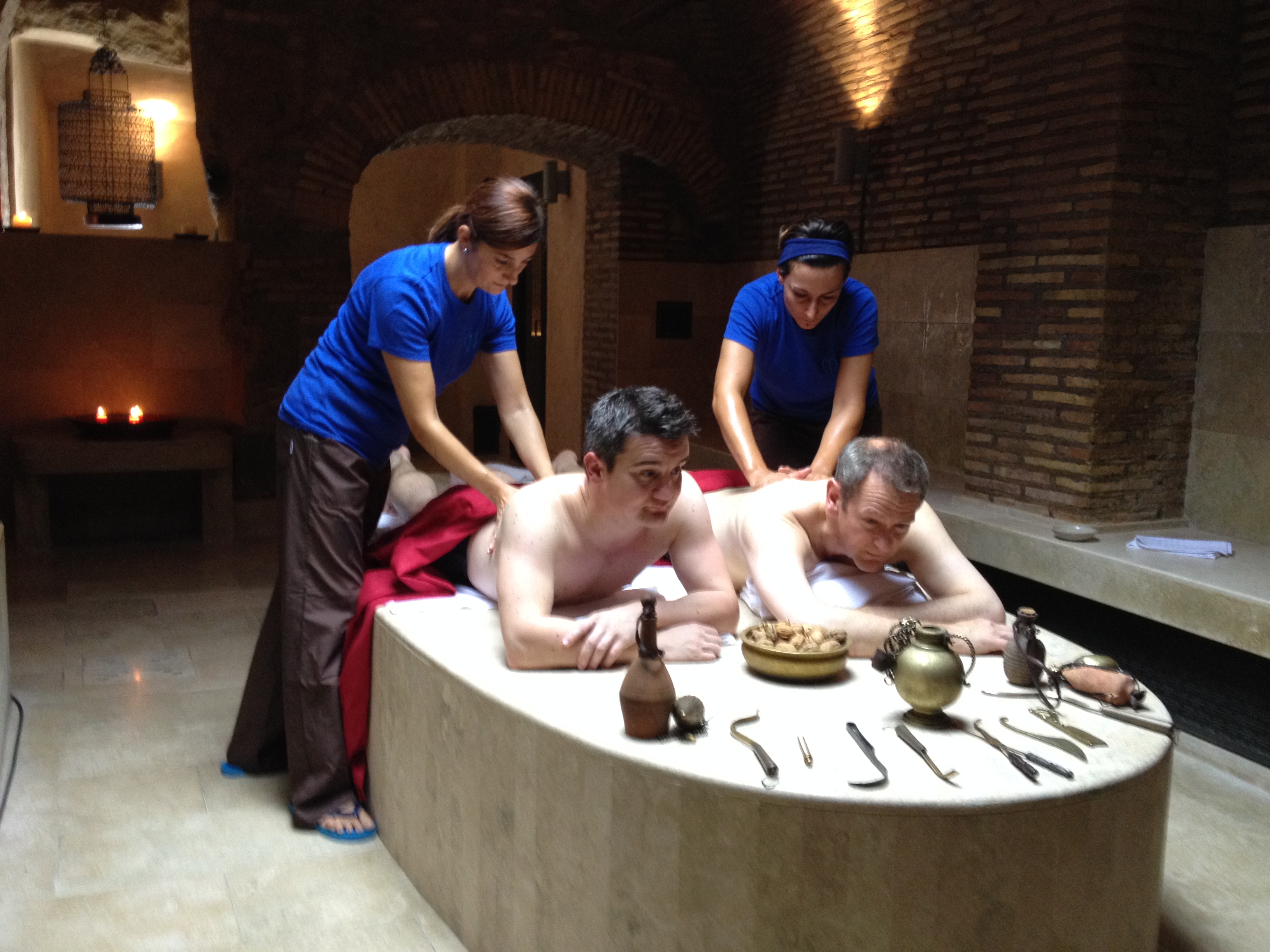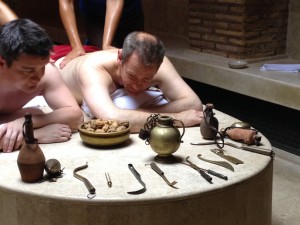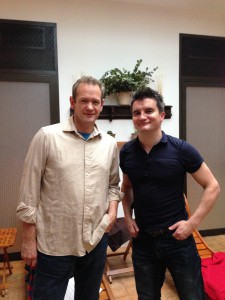
June 4, 2015, by Lindsay Brooke
Strigils, hot walnuts and a Roman bath.
Over four and a half million people tuned into BBC One at 9 o’clock on Monday night to see The University of Nottingham’s Dr Mark Bradley, dressed for the occasion, talking about ancient Roman bathing practices and some of the more raunchy aspects of Roman spas. Dr Bradley, an expert in ancient history, featured in the documentary ‘Rome’s Invisible City‘.
 Presented by Alexander Armstrong the programme used cutting-edge 3D scanning technology, to explore the underground treasures of ancient Rome – the aqueducts, sewers, underground cults and catacombs – that underpinned Europe’s first metropolis.
Presented by Alexander Armstrong the programme used cutting-edge 3D scanning technology, to explore the underground treasures of ancient Rome – the aqueducts, sewers, underground cults and catacombs – that underpinned Europe’s first metropolis.
Dr Bradley showed Alexander Armstrong how to use a strigil (an ancient bath tool used to remove oil from the skin) and explained what Romans used scalding hot walnuts for.
Here’s Dr Bradley’s account of the film shoot:
 It was 6 am on a warm September morning when Alexander Armstrong and I arrived at Acqua Madre, a Hammam (Roman Bath) in the Ghetto region of central Rome, to film a scene about ancient Roman bathing practices for the BBC documentary ‘Rome’s Invisible City’.
It was 6 am on a warm September morning when Alexander Armstrong and I arrived at Acqua Madre, a Hammam (Roman Bath) in the Ghetto region of central Rome, to film a scene about ancient Roman bathing practices for the BBC documentary ‘Rome’s Invisible City’.
Acqua Madre is a traditional Turkish bathing establishment, which claims to reproduce, in its authentic underground setting amid the foundations of an ancient Roman edifice, the rituals and experiences of bathing that would be familiar to all Romans high and low. Indeed the sequence of Turkish baths – warm room, hot room, cold plunge, relaxation and massage – derives directly from the tepidarium-caldarium-frigidarium sequence that appears to have been a standard feature of the ancient Roman bathing routine. Acqua Madre doesn’t typically scrape its clients with razor-sharp strigils or singe their excess body-hair with scalding-hot walnuts, but this is the routine I had to describe to Xander for the documentary in order to expose the strange and almost obsessive cleansing and grooming habits of the ancient Romans.
Of course the producers wanted to hear about the raunchy details of Roman bathing, so it didn’t take long to tease out of me some of the stories about the conspiracies and orgies that dominate ancient accounts of the baths.
This was a short scene in a grand and ambitious documentary probing the underbelly of ancient Rome – the aqueducts, sewers, underground cults and catacombs that the programme’s stunning graphic reconstructions demonstrate still stretch for miles and miles under the city (one Roman writer described Rome as a ‘hanging city’ because the subterranean tunnel network was so extensive).
Why me?
I was approached because I’m an old hand at this sort of thing: the programme’s academic presenter, Michael Scott, was somebody I taught back when I was a PhD student in Cambridge and so knew plenty about my research interests in the less palatable aspects of Roman life. In addition, I had already shown Simon Sebag Montefiore down into the ancient sewers of Rome back in 2012 for a BBC4 documentary titled ‘Rome: A History of the Eternal City’ in which I was the main academic consultant, and have made a number of other television and radio appearances to talk about my research. My current research concentrates on the senses in classical antiquity, particularly Roman approaches to smell, and this emphasis on reconstructing the experiences of ancient life – the colours, sounds, smells, tastes and feelings of antiquity – is one that aligns nearly to the aims and objectives of twenty-first-century television documentaries, for which ancient Rome has triggered a flurry of interest in recent years. Where better than the baths for exploring the sensations and sensualism of Roman life?
Making an early start
The early start for this shoot was not out of choice. Xander and I had to be done filming and out of the Hammam by 10 am, when the establishment opened for its weekly women-only Wednesday. No exceptions could be made: this was a day when the women of modern Rome could bathe and relax without interruption by the menfolk. The emperor Hadrian, who himself legislated against mixed bathing in the city two thousand years ago, would have been proud.
Want to learn more?
The one hour documentary is available on BBC iPlayer until the end of June.
No comments yet, fill out a comment to be the first

Leave a Reply